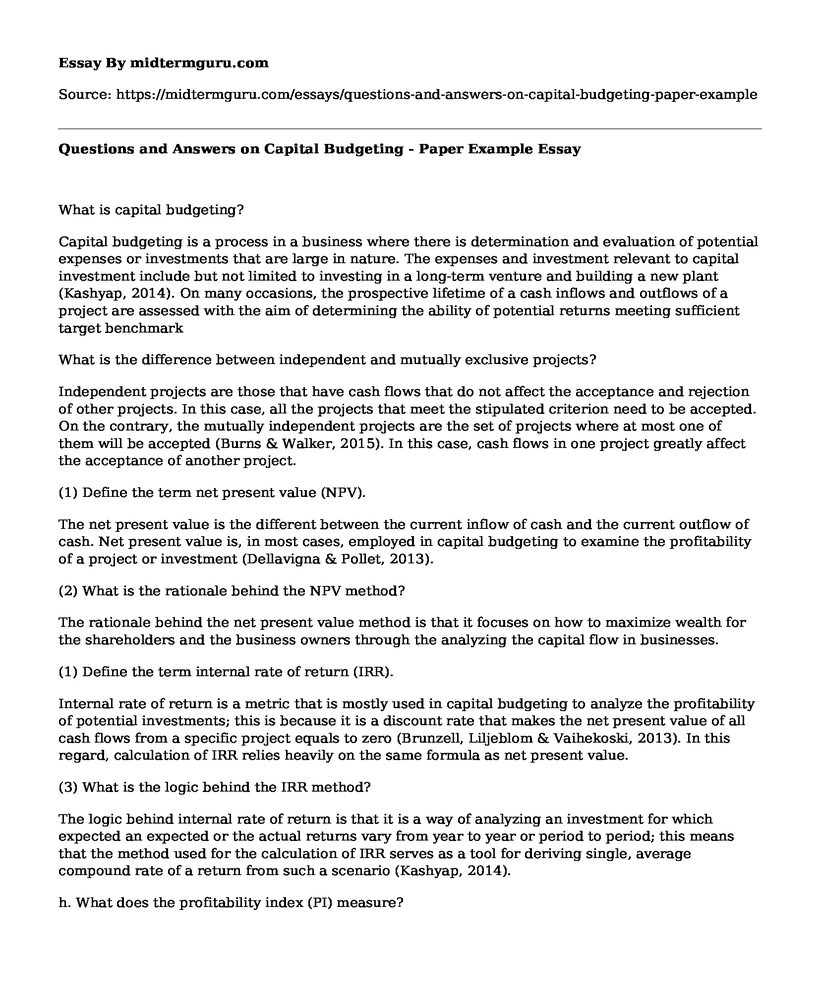What is capital budgeting?
Capital budgeting is a process in a business where there is determination and evaluation of potential expenses or investments that are large in nature. The expenses and investment relevant to capital investment include but not limited to investing in a long-term venture and building a new plant (Kashyap, 2014). On many occasions, the prospective lifetime of a cash inflows and outflows of a project are assessed with the aim of determining the ability of potential returns meeting sufficient target benchmark
What is the difference between independent and mutually exclusive projects?
Independent projects are those that have cash flows that do not affect the acceptance and rejection of other projects. In this case, all the projects that meet the stipulated criterion need to be accepted. On the contrary, the mutually independent projects are the set of projects where at most one of them will be accepted (Burns & Walker, 2015). In this case, cash flows in one project greatly affect the acceptance of another project.
(1) Define the term net present value (NPV).
The net present value is the different between the current inflow of cash and the current outflow of cash. Net present value is, in most cases, employed in capital budgeting to examine the profitability of a project or investment (Dellavigna & Pollet, 2013).
(2) What is the rationale behind the NPV method?
The rationale behind the net present value method is that it focuses on how to maximize wealth for the shareholders and the business owners through the analyzing the capital flow in businesses.
(1) Define the term internal rate of return (IRR).
Internal rate of return is a metric that is mostly used in capital budgeting to analyze the profitability of potential investments; this is because it is a discount rate that makes the net present value of all cash flows from a specific project equals to zero (Brunzell, Liljeblom & Vaihekoski, 2013). In this regard, calculation of IRR relies heavily on the same formula as net present value.
(3) What is the logic behind the IRR method?
The logic behind internal rate of return is that it is a way of analyzing an investment for which expected an expected or the actual returns vary from year to year or period to period; this means that the method used for the calculation of IRR serves as a tool for deriving single, average compound rate of a return from such a scenario (Kashyap, 2014).
h. What does the profitability index (PI) measure?
Profitability index, otherwise called profit investment ration (PIR) or value investment ration (VIR) measures the relationship between the costs and the benefits of a proposed project by using a ration. The ration is the PV of future cash flows divided by initial investment (Burns & Walker, 2015).
(1) What is the payback period?
Payback period is the length of time that an investment requires to recover the amount of capital used for the start-up or its total cost; this depends on the duration within which profits and revenue of projects to recover the initial capital outlay (Dellavigna & Pollet, 2013).
(2) What is the rationale for the payback method?
The rationale for the payback method is that it represents a kind of breakeven analysis and tell at what point in time a project will break even in a cash flow sense.
(3) What is the difference between the regular and discounted payback periods?
Regular payback period is the duration of time that a project would take to recover the initial capital outlay. On the other hand, a discounted payback period is the duration that a project would take to break even from undertaking initial capital outlay through discounting future cash flows and recognition of time value of money (Kashyap, 2014).
(4) What is the main disadvantage of discounted payback? Is the payback method of any real
usefulness in capital budgeting decisions?
The main disadvantage of discounted payback is that there is no consideration of time value when calculating the payback period. In this case, any cash received is given the same weight as the first year; this leads to overstating of time of recovering the initial investment (Dellavigna & Pollet, 2013). Discounted payback helps managers to know when they will recoup initial investment.
References
Brunzell, T., Liljeblom, E., & Vaihekoski, M. (2013). Determinants of capital budgeting methods and hurdle rates in Nordic firms. Accounting & Finance, 53(1), 85-110.
Burns, R., & Walker, J. (2015). Capital budgeting surveys: the future is now.
Dellavigna, S., & Pollet, J. M. (2013). Capital budgeting versus market timing: An evaluation using demographics. The Journal of Finance, 68(1), 237-270.
Kashyap, A. (2014). Capital Allocating Decisions: Time Value of Money. Asian Journal of Management, 5(1), 106-110.
Cite this page
Questions and Answers on Capital Budgeting - Paper Example. (2021, Jul 02). Retrieved from https://midtermguru.com/essays/questions-and-answers-on-capital-budgeting-paper-example
If you are the original author of this essay and no longer wish to have it published on the midtermguru.com website, please click below to request its removal:
- Main Ethical Issues in Audit Firms - Paper Example
- Electronic Fund Transfers - Paper Example
- Delta Air Lines Inc Case Study
- Ratios and Financial Planning in Tuxedo Air Inc - Paper Example
- Compare and Contrast Essay Sample on Tax Abatement Vs. Tax Increment Financing
- Resilient Financial System: Australia's Changes Since 2017 - Research Paper
- Chile: The Highest Ranked Economy in Latin America - Essay Sample







